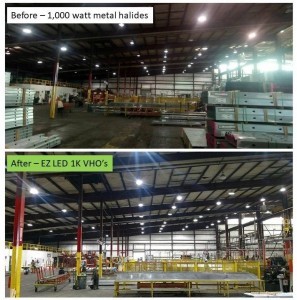How Does Lighting Inefficiency Affect Your Business?
By Leah • Nov 12, 2019
No part of your business is going to be 100% efficient. You can never get out all that you put in. Yet striving for such efficiency is the goal of any good business. The benefits might seem obvious in terms of productivity and success, but how does that apply to lighting? At OEO, we show you how lighting inefficiency negatively affects your business and what you can do to stop this from happening.
Why is Lighting Inefficient?
To power any electrical appliance you need to use electrical energy. This energy is taken from the grid (although many businesses are now supplementing their electrical energy from more renewable sources) and travels into the lighting fixture to turn it on and maintain light output.
But not all of this energy is converted into light. In certain lighting fixtures, the majority of electrical energy is lost as heat. In industrial settings, high intensity discharge bulbs (HIDs) such as metal halide lamps are said to be 3 to 5 times more efficient than incandescent lighting. However, when you consider some incandescent lights can lose up to 90% of their electrical energy to heat, this does not equal high efficiency.
Lighting Inefficiency Costs Money
With the massive spaces industrial businesses require, many lighting fixtures are used to maintain operation. The lighting energy used to run them all has a serious influence on your overheads. While business is good, these overheads may be covered, but they will still cut into profit margins. When business is poor, running costs exacerbated by inefficient lighting can break a company.
Lighting Inefficiency Affects Other Appliances
Another knock-on effect of inefficient lighting is a practical one. With so much electrical energy being converted to heat, the indoor temperatures of an industrial space can be astronomical. In warmer climates, this can mean safety issues for workers and an increased reliance on ambient temperature control.
The additional heat created by inefficient lighting can mean air conditioning and other coolant systems will have to work overtime, putting additional strain on overheads. Placement of lamps is also very important as some HIDs create so much heat they can ignite flammable material or even burn workers. Inefficiency Can Prevent Growth
Inefficiency Can Prevent Growth
The money lost to high overheads may not be enough to shut a commercial operation down, but the impact can still be felt in innovation. Lacking funds to develop new means of production or strategize new operations can have serious impacts long term.
Not only does inefficient lighting take away from these opportunities, it also prevents growth in terms of what you can do with lighting itself. HIDs not only require a lot of energy to turn on, but they require time. This means they cannot be programmed or even used on basic motion detector systems. The end result is a business missing out on the many benefits programmable lighting can create, both for their operations and their workers.
Lighting Inefficiency Can Mean No More Business
Energy inefficiency across the board is having a detrimental effect on our energy resources. It is also contributing to harmful climate change which is placing everyone in jeopardy, including your business. Reducing inefficiency creates savings in terms of overall energy used, as well as allowing us to grow into the future. A cleaner, safer and more profitable future is more likely with efficient lighting.
This is where LED comes in. At up to 80% more efficient than HIDs, they are cleanest and least consumptive lighting technology available. They not only perform more efficiently, but create better quality light which is adaptable to industry developments. And LED lighting is still in its relative infancy, so greater efficiency is still to come.
With high-bay lighting, inefficient lamps will hurt your business immediately. Bulbs like the OEO EZ LED 1K ULTRA can create light which can fill large high-bay spaces and do it more cost effectively, more safely and, of course, more energy efficiently. Contact us to see where lamps like this can help you.
